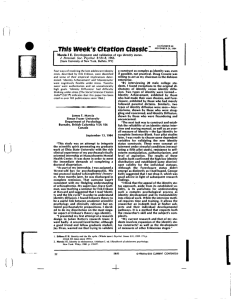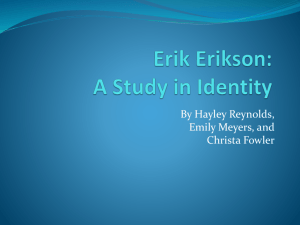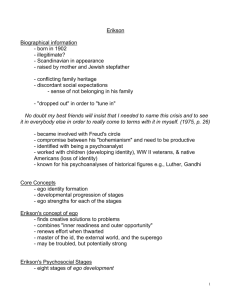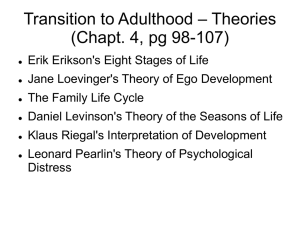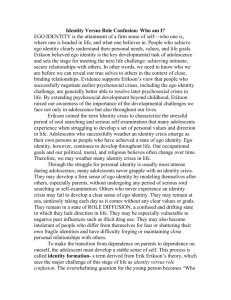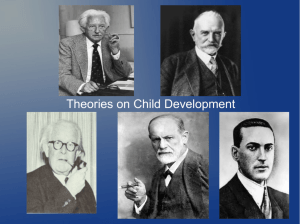IDENTITY DEVELOPMENT
advertisement
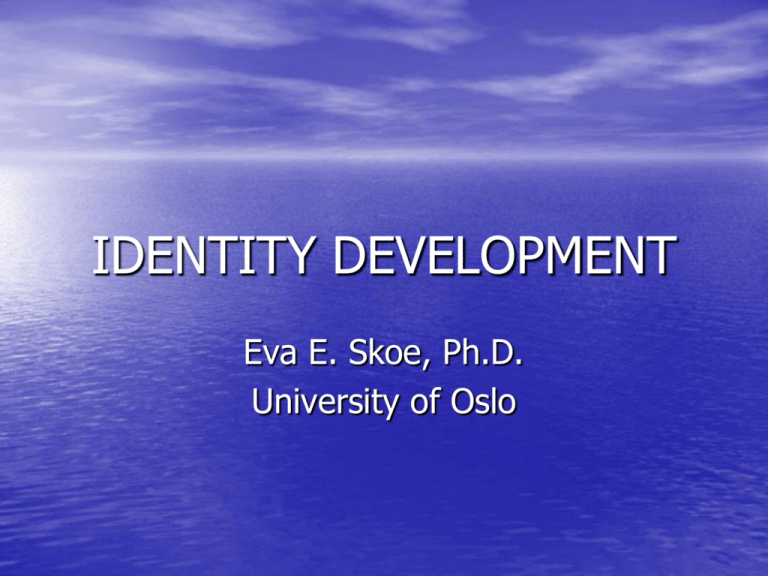
IDENTITY DEVELOPMENT Eva E. Skoe, Ph.D. University of Oslo Understanding of Ego Identity Begins with Erik Erikson • • • • • • • Erik H. Erikson (1904-1994) Never knew biological father Mother an artist Invited by friend Peter Blos to teach at Freud’s school in Vienna Invited to be trained in analysis Worked clinically with World War II veterans First used concept “Identity” EGO IDENTITY CONCEPT “What impressed me the most was the loss in these men of a sense of identity. They knew who they were, they had a personal identity. But it was as if, subjectively their lives no longer hung together--and never would again. There was a central disturbance of what I then started to call ego identity. …this sense of identity provides the ability to experience one’s self as something that has continuity and sameness and to act accordingly.” (Erikson, 1963, p. 42) DIMENSIONS OF EGO IDENTITY • Biological • Psychological • Social • Cultural – Historical - Economical Erikson’s Identity-Defining Arenas • Vocational domains • Ideological values • Sexuality Erikson’s Key Identity Concepts • Identification • Identity Formation Process • Identity Achievement • Identity Crisis • Negative Identity Negativ Identity • ”a maladaptive identity resolution whereby an • individual bases an identity on all the identifications and roles presented to them in their earlier development as being undesirable or even dangerous” (Kroger, 2007, p. 11) Erikson wrote about the daughter of an influential southern preacher found among narcotics addicts in Chicago, and about Martin Luther becoming a munk instead of a lawyer. Eriksons Utviklingsstadier • • • • • • • • 1. 2. 3. 4. 5. 6. 7. 8. Basic Trust & Mistrust (Hope/Faith) Autonomy & Shame & Doubt (Will) Initiative & Guilt (Purpose) Industry & Inferiority (Competence) Identity & Role Diffusion (Fidelity) Intimacy & Isolation (Love) Generativity & Stagnation (Care) Integrity & Despair (Wisdom) EPIGENSIS Resolution to Identity Achievement versus Role Confusion • “An optimal sense of identity . .. Is experienced merely as a sense of psychosocial well-being. • Its most obvious concomitants are a feeling of being at home in one’s body, a sense of ‘knowing where one is going,’ and an inner assuredness of anticipated recognition from those who count.” (Erikson, 1968, p. 165) James Marcia • Empirical Elaboration of Erikson’s Identity Achievement vs. Role Confusion Concept EGO IDENTITY STATUS (Marcia, 1980) • IDENTITY ACHIEVED Has gone through a period of exploration of alternatives & has made well-defined commitments. • MORATORIUM Is in the exploration period with commitments only vaguely formed. EGO IDENTITY STATUS (Marcia, 1980) • IDENTITY FORECLOSED Has undergone no, or very little, exploration & remains firmly committed to childhood-based values. • IDENTITY DIFFUSED Whether having explored alternatives or not, is uncommitted to any definite life directions. EGO IDENTITY INTERVIEW (Marcia, 1980) • PROCESS VARIABLES: exploration committment • CONTENT VARIABLES: Occupation Religion (or philosophy) Politics Sex roles Sexuality Criteria for Ego Identity Statuses (Marcia,1966) --Identity Achievement --Moratorium --Foreclosure --Diffusion _____________________________________________________ Identity Status Position on Achievement Foreclosure Diffusion Moratorium Occupation __________________________________________________________________________ Exploration Present Absent Present/ Absent In process Commitment Present Present Absent Vague ___________________________________________________________________ RESEARCH FINDINGS PERSONALITY • IDENTITY ACHIEVED Internal locus of control, high ego development, personal autonomy & self esteem. Rational decision-making strategies. • MORATORIUM High in anxiety, denial, projection & identification. Openness to experience. PERSONALITY • FORECLOSURE Authoritarianism, low levels of autonomy, external locus of control. Both genders strongly identify with their father & mother. • DIFFUSED Low levels of: parent identification, self-esteem, personal autonomy & ego development. External locus of control. Shy. FAMILY STYLES OF COMMUNICATION • IDENTITY ACHIEVED High perceived companionship, physical affection & support of parents. Parental fairness in discipline with moderation in praise. Parental encouragement of independence. • MORATORIUM High perceived companionship, physical affection & support of parents. Parental fairness in discipline with moderation in praise. Parental encouragement of independence. FAMILY STYLES OF COMMUNICATION • FORECLOSURE High perceived companionship & support of parents. Low parental encouragement of independence. Parental over-controlling behaviors. • DIFFUSED High perceived parental rejection. Low affection from parents. Withdrawn or uninvolved behaviors from parents. Identity & Intimacy Issues of identity must be fairly well resolved before genuine intimacy is possible. (Erikson, 1968) The Intimacy Statuses (Orlofsky, Marcia, & Lesser, 1973) • INTIMATE Close relationships with friends, enduring committed relationship with partner. Openness of communication, mutual affection, respect for integrity of self & other. • PRE-INTIMATE Like intimate, but lacking stable, committed partnership. The Intimacy Statuses (Orlofsky, Marcia, & Lesser, 1973) • PSEUDOINTIMATE Involved in superficial relationships, often using people to get things for self. • STEREOTYPED Like pseudointimate, but lacking stable, committed partnership. • ISOLATE No close relationships. Constricted life space. The Intimacy Statuses • MERGER (Committed) Has established a long-term sexual relationship with partner, enmeshment & dependency. • MERGER (Uncommitted) Not established a long-term sexual relationship with a partner, friendships are characterized by dependency & enmeshment. Evaluation •ERIKSON •MARCIA
